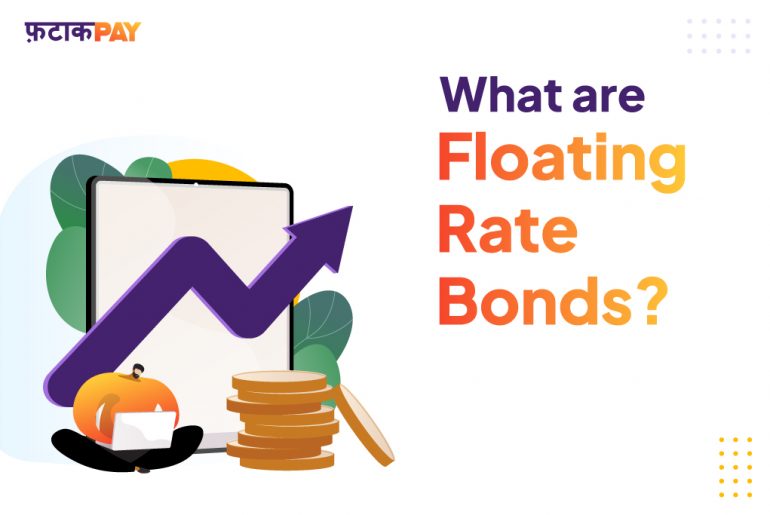Bonds typically have a predetermined coupon or interest rate. For instance, you may purchase a bond for Rs 10,000 with a 5% coupon rate. In the case of such a bond, the bond issuer will pay you Rs 500 in interest each year. This interest is fixed and does not change according to the market’s current interest rate. Let’s move
A variable rate bond, on the other hand, is a type of financial instrument in which the interest rate is not fixed but instead changes depending on the benchmark from which it is taken. Benchmarks are market tools that have an impact on the entire economy. As benchmarks for a variable rate bond, repo rates or reverse repo rates, for instance, can be specified.
How do floating rate bonds work?
In India, the government issues the majority of the floating rate bonds, which make up a sizeable portion of the market. For instance, in 2020, the RBI issued a bond with a floating rate and a six-month interest payment schedule.
The RBI changes the interest rate after six months. The interest rate on the current National Savings Certificate (NSC) is 35 basis points lower than the benchmark for the floating rate bond.
The National Savings Certificate currently has an interest rate of 6.8%. As a result, the interest rate for the floating rate bond issued by the RBI is 6.8% +.35% = 7.15%.
A variable rate bond typically has a maturity of two to five years and is issued by the government, financial institutions, and enterprises.
The frequency of interest payments for a floating bond can be quarterly, semi-annually, or annually.
What are the different classifications of a floating rate bond?
The two primary categories of floating rate bonds are:
Callable Floating Rate Bonds: Bonds with a call option that allow for a fluctuating interest rate are called callable floating rate bonds. After returning the initial principal amount to the bondholder, the issuer stops paying interest to the bondholder. With these types of floating-rate bonds, the issuer is safeguarded from declining or rising interest rates and has the option to redeem the bond before its maturity.
Non-callable Floating Rate Bonds: With these bonds, the issuer does not have the ability to call back the bond or retire the asset before maturity. Even if they have to suffer a loss after paying the interest, the issuer of such bonds is required to pay the interest rate generated from the underlying benchmark.
Advantages and Disadvantages of Floating Rate Bonds
Advantages
Less Volatility:
Bonds with floating rates are less susceptible to volatility or downward price movement since they can adjust to market interest rates. When the market interest rate declines, traditional fixed-rate bonds begin to exhibit lower yields.
Higher Returns:
Compared to many other financial vehicles, floating rate bonds offer larger yields. Furthermore, variable rate bonds can offer the bondholder substantial gains if market interest rates are rising.
Safe Investments:
Investors can purchase government-issued variable rate bonds if they want to protect their capital while still earning a high rate of interest. These bonds are safer because there is no credit risk and are benchmarked against government instruments like repo rates. There is very little likelihood that government-issued bonds will miss interest payments.
Diversification:
When market interest rates are low and predicted to rise in the future, investors wishing to diversify their portfolios among different asset classes can invest in floating-rate bonds. The principal amount will remain the same, but when the rates climb, so will the amount of payable interest.
Disadvantages:
Lower Yield:
Since floating rate bonds are tied to a benchmark with a short-term rate, they may end up giving investors a lower yield than fixed-rate bonds. The investor may receive lesser returns from floating rate bonds if the short-term benchmark rate declines.
Interest Rate Risk:
There is no guarantee that a floating rate bond’s interest rate would increase in a rising environment with the same speed as the market rate. Due to the bond underperforming compared to market interest rates, the bondholder may incur interest rate risk.
Default Risk:
Bonds with floating rates are subject to default risk since the institution could stop making interest payments due to a lack of resources. The investors can suffer a loss in relation to the original sum and upcoming interest payments if this occurs.
Call Risk:
Investors who purchase callable variable rate bonds run the risk of having the bonds repurchased by the issuer. The investors lose money on future interest payments even while they receive their principal back.
If you think that market interest rates may increase soon, floating rate bonds are a terrific way to earn a big quantity of interest. However, as floating rate bonds in India also include significant risks, it is always advisable to get financial advice before making a purchase.
Additional links:
Thank you for reading our LinkedIn article! Here are some other blogs/LinkedIn articles for you to check out.
https://fatakpay.com/blog/how-to-manage-your-personal-finance/
https://fatakpay.com/blog/discover-the-wonders-of-an-emi-benefits-and-disadvantages-explained/
https://www.linkedin.com/pulse/what-nbfc-fatakpay/?trackingId=DYxaWIZVg4eCj2%2FYGCvqxw%3D%3D
About FatakPay:
FatakPay provides virtual credit facilities for all. It’s available on your phone and caters to your everyday needs in both online and offline formats. Payments are done seamlessly through UPI/QR codes. The solution provides an almost zero cost, free, quick, transparent and secure way to transact in a multilingual format with a Scan Now, Pay Later facility and easy repayment options.
Link to FatakPay App: https://play.google.com/store/apps/details?id=com.fatakpay
Link to the Website: https://fatakpay.com/







